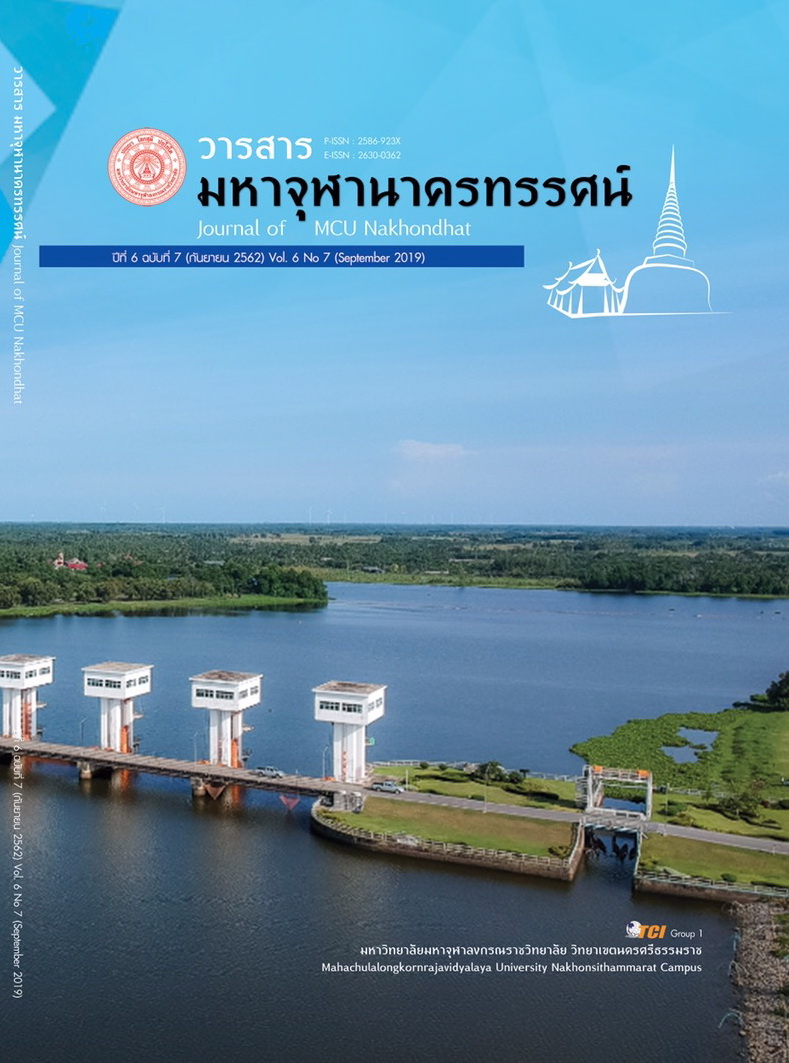THE SUCCESS OF BUDGET SPENDING OF THE DEPARTMENT OF FISHERIES TO DEVELOPMENT BUNGBORAPET IN B.E 2557 - 2560
Main Article Content
Abstract
This research to study 1) The state budget for the development of Bung Boraphet. 2) The government budget system for the development of Bung Borapet; and 3) To present the success of the government budget for the development of Bung Boraphet. This is a qualitative research. Analysis of documents In-depth interviews and group discussions from key informants were conducted using a selective approach. Using content analysis The findings are summarized as follows.
- The government has a policy to develop large water resources and allocate budget appropriately and continuously. The budget for dredging and weeding and the budget for the development of Bung Boraphet as a tourist attraction.
- The system of public budgets for the development of Bung Boraphet consists of the preparation of a project / activity plan. And considering the budget received to carry out the project / activity. To the various agencies in the area, spend the budget to accomplish the objectives of the project and the policy laid down.
- The successful implementation of the government budget for the development of Bung Boraphet in the management has been promoted and disclosed information. To the public thoroughly. Integration of inter-agency collaboration. The fiscal budget is budgeted according to the budget allocation strategy, taking into account the problems and needs of the area.
Article Details
How to Cite
ประสาทแก้ว ไ., & ไวสำรวจ ก. (2019). THE SUCCESS OF BUDGET SPENDING OF THE DEPARTMENT OF FISHERIES TO DEVELOPMENT BUNGBORAPET IN B.E 2557 - 2560. Journal of MCU Nakhondhat, 6(7), 3424–3435. retrieved from https://so03.tci-thaijo.org/index.php/JMND/article/view/206989
Section
Research Articles
References
จุมพล หนิมพานิช. (2554). การนำนโยบายไปสู่การปฏิบัติ : มุมมองในทัศนะทางรัฐศาสตร์ การเมืองและรัฐประศาสตร์ การบริหารและกรณีศึกษาของไทย. กรุงเทพมหานคร: จุฬาลงกรณ์มหาวิทยาลัย.
รัชดาภรณ์ เมธาวรารักษ์. (2550). ปัญหาทางกฏหมายเกี่ยวกับการบริหารงบประมาณแผ่นดินในประเทศไทย. ใน วิทยานิพนธ์นิติศาสตรมหาบัณฑิต สาขาวิชานิติศาสตร์. มหาวิทยาลัยธุรกิจบัณฑิตย์.
วรเดช จันทรศร. (2551). ทฤษฎีการนำนโยบายสาธารณะไปปฏิบัติ. (พิมพ์ครั้งที่ 2 ). กรุงเทพมหานคร: บริษัท พริกหวานกราฟฟิค จำกัด.
ศูนย์วิจัยและฝึกอบรมบึงบอระเพ็ด. (ม.ป.ป.). ฐานข้อมูลบึงบอระเพ็ด. เรียกใช้เมื่อ 3 มกราคม 2560 จาก https://na.mahidol.ac.th/bungresearch/index.php/database
สำนักข่าว MOREMOVE. (2559). ทวงคืนสมบัติชาติ นายทุน-ชาวบ้านรุกล้ำ "บึงบอระเพ็ด" กว่า 5 หมื่นไร่. เรียกใช้เมื่อ 13 มิถุนายน 2560 จาก https://moremove.com/mmV5/
สุพาดา สิริกุตตา และคณะ. (2553). การวางแผนและการบริหารโครงการ. กรุงเทพมหานคร: ไดมอนด์ อินบิซิเนสเวิลด์.
อรสา จุลลสุคนธ์ และคณะ. (2559). ปัจจัยความสำเร็จของการใช้งบประมาณในการวิจัยของนักวิจัยในการวิชาการเกษตร. ใน รายงานการวิจัย. มหาวิทยาลัยสุโขทัยธรรมาธิราช.
Manatti,G. (2011). The quality of stakeholder engagement in sustainability reporting: empirical evidence and critical points. Corporate Social Responsibility and Environmental Management, 18(2), 110-122.
รัชดาภรณ์ เมธาวรารักษ์. (2550). ปัญหาทางกฏหมายเกี่ยวกับการบริหารงบประมาณแผ่นดินในประเทศไทย. ใน วิทยานิพนธ์นิติศาสตรมหาบัณฑิต สาขาวิชานิติศาสตร์. มหาวิทยาลัยธุรกิจบัณฑิตย์.
วรเดช จันทรศร. (2551). ทฤษฎีการนำนโยบายสาธารณะไปปฏิบัติ. (พิมพ์ครั้งที่ 2 ). กรุงเทพมหานคร: บริษัท พริกหวานกราฟฟิค จำกัด.
ศูนย์วิจัยและฝึกอบรมบึงบอระเพ็ด. (ม.ป.ป.). ฐานข้อมูลบึงบอระเพ็ด. เรียกใช้เมื่อ 3 มกราคม 2560 จาก https://na.mahidol.ac.th/bungresearch/index.php/database
สำนักข่าว MOREMOVE. (2559). ทวงคืนสมบัติชาติ นายทุน-ชาวบ้านรุกล้ำ "บึงบอระเพ็ด" กว่า 5 หมื่นไร่. เรียกใช้เมื่อ 13 มิถุนายน 2560 จาก https://moremove.com/mmV5/
สุพาดา สิริกุตตา และคณะ. (2553). การวางแผนและการบริหารโครงการ. กรุงเทพมหานคร: ไดมอนด์ อินบิซิเนสเวิลด์.
อรสา จุลลสุคนธ์ และคณะ. (2559). ปัจจัยความสำเร็จของการใช้งบประมาณในการวิจัยของนักวิจัยในการวิชาการเกษตร. ใน รายงานการวิจัย. มหาวิทยาลัยสุโขทัยธรรมาธิราช.
Manatti,G. (2011). The quality of stakeholder engagement in sustainability reporting: empirical evidence and critical points. Corporate Social Responsibility and Environmental Management, 18(2), 110-122.


